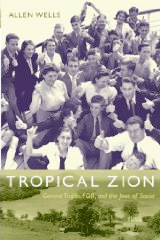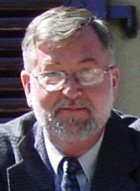 Review by John M. Handley, Ph.D.
Review by John M. Handley, Ph.D.
Tropical Zion: General Trujillo, FDR, and the Jews of Sosua, by Allen Wells, Duke University Press, 2009, 480 pages, $27.95, ISBN 978-0-8223-4407-0.
Allen Wells is the Roger Howell Jr. Professor of History at Bowdoin College and author of Yucatan’s Golden Age, which covers the period 1860 to 1915. He also co-authored Summer of Discontent, Seasons of Upheaval, addressing elite politics and rural rebellion in Yucatan from 1876 to 1915, and co-edited The Second Conquest of Latin America, which investigates coffee, henequen, and oil during the export boon of 1850 to 1930.
Dr. Wells, the son of Heinrich Wasservogel and one of the original Sosua settlers, spent seven years researching the flight of 750 European Jewish refugees to the settlement at Sosua in the Dominican Republic. He documents the bureaucratic decision-making by the international community from 1939 and throughout World War II when nations grappled with the increased demand to take refugees by slashing rather than increasing their respective refugee quotas in order to prevent the Nazis from using these quotas to infiltrate into their respective countries.
The United States, for example, reduced its annual quota of Russian and Eastern European Jews from over 20,000 to approximately 2,000 (page 58). Of a total 210,000 U.S.-mandated quotas for immigrants from Nazi-controlled countries, only 2100 were actually admitted into the United States during the duration of the war (page 113). Jewish refugees could no longer legally depart Germany or Austria or any of the countries conquered by Germany, which left thousands of refugees caught in transit in Switzerland, or Singapore, or Spain, or Portugal with no legal documentation into another country. These refugees, for the most part, became wards of the state, living in state-run “refugee” centers.
The one country in the world that responded positively to this disaster was the Dominican Republic. Although under the harsh rule of the dictator General Trujillo, in 1938 the Dominican Republic sent representatives to a conference on refugees from Nazism held at Evian, France and offered to take in 100,000 European Jewish refugees. General Trujillo had very good reasons for his magnanimity. Shortly before this offer, Dominican Republic forces had massacred some 15,000 unarmed Haitians living inside their border and received the condemnation of the United States and many other states. The dictator also wanted white “European” stock to settle on and populate portions of the country to deny these areas to the faster growing “black” population.
The irony that comes through the many pages that address ethnicity is the fact that European Jews were desperate to leave a dictatorship that discriminated against their religious beliefs while accepting and even embracing another dictator who valued the color of their skin over that of a large portion of his own citizens.
The author devotes the bulk of this book to the political machinations that involved various U.S. government officials from the FDR administration, including FDR himself, and General Trujillo. He also addresses the several Jewish organizations that worked, sometimes at cross purposes, to assist Jews escaping from Nazi-held potions of Europe. The reader will get an insight into the conflict between the pro-Zionist camp that hoped to establish a homeland in Palestine and the other Jewish agencies and the non-Zionist camp that simply wanted to assist Jews escape Nazism regardless of where they might end up. The author describes the success of an experiment in Crimea with Jewish farmers which became, at first, the model for the Sosua experiment in the Dominican Republic. He also describes how this experiment changes and morphs over time with the community eventually evolving into a cattle ranching facility in which the bulk of the profit that sustained the community came from selling milk and cheese.
Allen Wells traces the arrival of the first Jewish families, including his father, to the Sosua Settlement in the Dominican Republic and the subsequent arrival of other refugees, eventually numbering 750 – a far cry from the 100,000 the government said it would accept. He explains the numerous factors that worked to limit refugee immigration, starting with the fact that the Dominican Republic primarily wanted to bring in young, healthy, farmers and then provided the refugees with land more suitable for ranching than farming.![]()

Dr. John M. Handley, American Diplomacy Publishers Vice-President for Outreach, is a Professor of International Relations for Webster University’s Ft. Bragg and Pope AFB campuses. A retired U.S. Army Colonel, Dr. Handley spent his Army career in military intelligence, including as a defense attaché, the dean of the School of Attaché Training at the Defense Intelligence College, and deputy, resource management, for the Defense Intelligence Agency.
